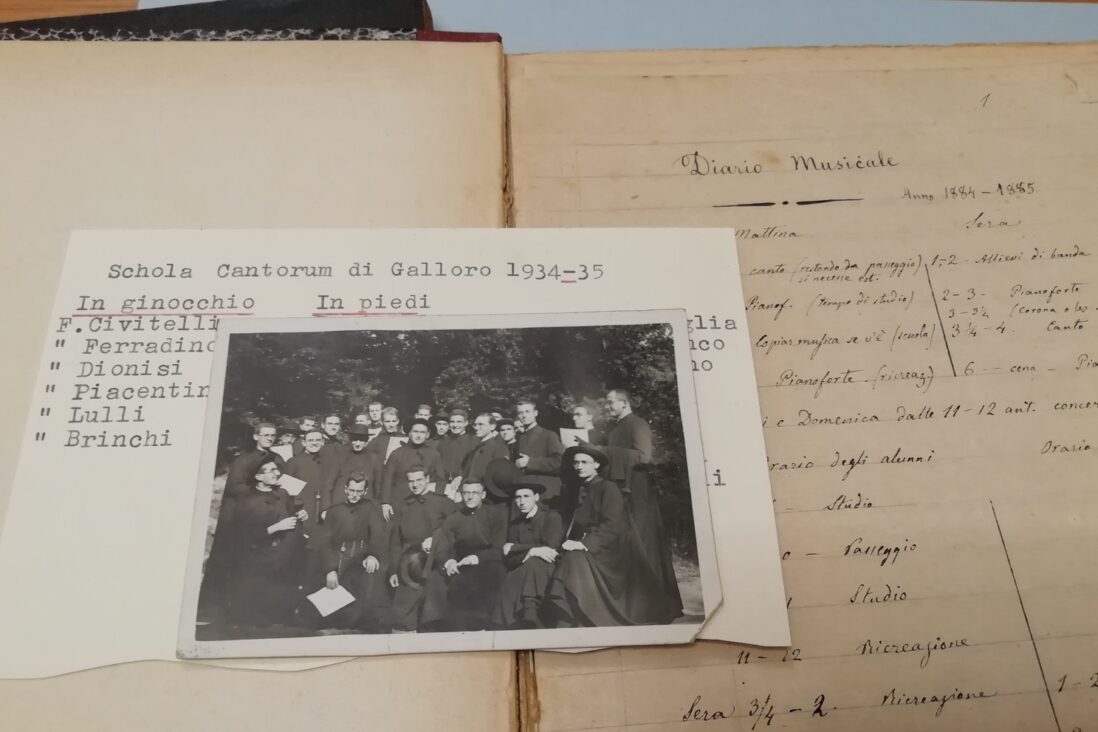Music in colleges and novitiates

Music did not remain outside the walls of the novitiate, as one might perhaps think, but was an integral part of the novices’ lives and their training.
At Galloro, where the novitiate was based from 1929 until the 1960s, there was a veritable ‘Schola cantorum’. The aspiring religious, portrayed in the photo during a visit to the Pontifical Gregorian University, were engaged in the study of singing and music.
They animated liturgies and moments of prayer in the novitiate, performing different psalms and songs according to the liturgical calendar.
Also in Loreto, in the same years, there was a Schola cantorum for apostles in the apostolic school “St. John Berchmans”.
Among the papers produced in Loreto is the diary of the Schola cantorum, from which we can reconstruct the musical performances on various feast days.
The diary opens on 8 September 1939, the nativity of Mary, in whose honour the Ave Maria was performed:
twice the Ave Maria composed by Perosi, the Sanctus by Camattari, O salutaris also by Perosi, ‘O Quam Suavis’ by Oreste Ravanello and ‘Quanto è soave al core’ by the same author.
It was also a feast day on 22 November, St Cecilia, in whose honour the Exaudi Domine – Perosi and the Alleluia were performed, among others.
On the occasion of the spiritual exercises, held between 23 and 25 November, the diary records the day’s activities:
At the introduction and morning and evening meditations [was performed] “Veni Creator” intoned by one of the prefect fathers and accompanied by the Harmonium. At 10 o’clock the Office of Our Lady was immediately followed by the “Te Deum”. In the evening the Eucharistic blessing with the singing of the “Iste Confessor”[…] After the last meditation, the Kiss of the Crucifix, accompanied by the singing of the Miserere, very slow and quiet.
Leafing through the diary again, there are numerous compositions by Perosi performed by the schola cantorum: O Salutaris hostia, Tota pulchra, Ave Verum, Tantum ergo.
There are also works by Mascagni, Schubert, Scarlatti, Händel, Tomadini, Mendelsshon.
The Catholic Action hymn ‘Living Confirmation’ is also performed.
In February, for the Carnival performances were performed:
Farsa lirica in one act by Alfonsi
Il terzetto di Crispino e la Comare by the Ricci brothers
The Duet of the Secret Marriage by Cimarosa
The Romanza Spazzacamino by Cagliero.
There is an interesting note on 6 January 1941, at the end of a long musical programme on the occasion of Epiphany:
“Everything went more than reasonably well, despite the rumours spread at the prologue and conclusion of the academy. The vocal director should not listen to rumours that the voices are weak, especially those who know less than nothing about singing, and should persuade himself that even donkeys can sing loudly, and only a few can sing softly. As for chatter, it is philosophy that is needed: let people say and do the opposite of what they say.”
Another note reminds us not to let children eat too many oranges and sweets so as not to ruin their voices during performances.
Music was also taught in all Jesuit colleges and the annual essays and academies were interspersed with performances of musical works.
A music diary written in Strada, where there was a Jesuit college closed in 1925, is preserved, in which the timetable of music lessons is recorded.
These were diversified for band students, piano students and the choir.
Operas, chamber music, folk songs, stornelli and hymns, the musical repertoire available to the pupils was indeed wide and varied.
Who accompanied them?
The sources preserve the names and faces of music teachers, almost all of whom were lay people; sometimes there were also some particularly gifted young scholastics who accompanied the college choir during their teaching.
In religion schools and Jesuit colleges, the rental of pianos or the purchase of sheet music and musical texts is frequently recorded as an expense.
Archival sources manage to restore three-dimensionality to the history and historical subjects that are mentioned in the papers, in this case helping to bring voices, melodies and music back to life.
Maria Macchi











